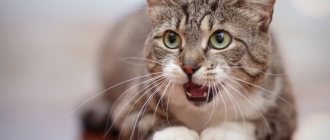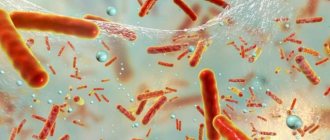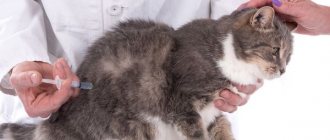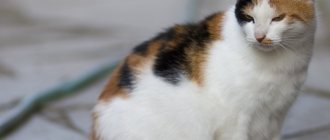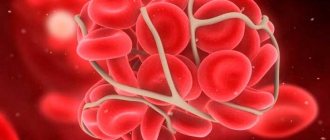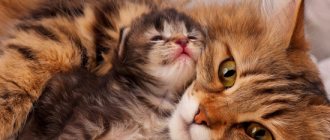Standards of behavior - what to expect from a cat after giving birth?
Strange behavior of a cat after giving birth may be due to simple mistakes of an inexperienced owner or too active maternal instinct. In both cases, the situation needs to be monitored and gently adjusted.
Most cats that have recently given birth show a restless state, but at the same time behave confidently and know exactly what to do. In the first few weeks, the cat desperately wants to control her offspring. The young mother is constantly with the kittens, licks them, purrs loudly and protects them from annoying attention.
For his part, the owner must show maximum loyalty, but control the development of the kittens. To reduce the anxiety of a young mother, the nest with kittens must be isolated in a separate room. Place a water bowl, feeder and cat litter box next to the nest.
Important! Unless necessary, kittens should not be touched more than once a day. In the first two weeks, to monitor growth, it is recommended to weigh and examine kittens once every 1-2 days.
Try to examine the kittens and change the bedding at the same time. Talk to the cat, calm it down, and with all your appearance make it clear that you do not pretend to be a guardian. The first instinct that guides a young mother is the desire for safety. The cat will make every effort to ensure that its offspring are hidden from annoying attention and are warm and comfortable.
Only by ensuring maximum comfort and safety will the mother cat be able to relax and unwind. It is for this reason that it is important to prepare the nest for kittens several weeks before giving birth. This will give the cat time to get used to the place and make sure it is safe.
Immediately after the birth of a kitten, the cat pays maximum attention to removing mucus and fluid from the baby's respiratory tract. When the kitten starts to squeak, the cat pushes it towards the nipples. As soon as the kitten begins to suckle colostrum, the cat chews the umbilical cord and eats the afterbirth.
Possible problems
Malfunctions of the intestines. Both diarrhea and constipation are abnormalities that require attention during the postpartum period in a cat. In an uncomplicated condition, normalization of stool should occur within 24, maximum 48 hours. To make defecation easier, you can give your pet a little vegetable oil.
Frequent breathing in a cat is considered normal if it falls within the time frame of 105-15 minutes after pushing. If this period drags on, you should consult a doctor.
Vomiting is a sign that the cat has eaten too much afterbirth. After a few days everything should go away, otherwise you should consult a doctor.
If a cat pees blood in the first 24-48 hours after giving birth, it’s not scary; it’s urine mixed with discharge from the uterus. But if the situation does not change, you should sound the alarm.
Greenish or red discharge. Their presence is natural in the first 2-3 weeks after birth and should not cause alarm in the absence of diarrhea, vomiting and fever.
Impaired lactation in a cat. Experienced animals place kittens on their own; otherwise, owner intervention is required. Human assistance also includes applying pressure and massaging the nipples (if they are inverted). With a small amount of milk, kittens are fed with special food. If babies gain weight and do not squeak, everything is fine with lactation. Nursing cats also require a special menu (MoTHER and Babycat, Babycat instinctive from Royal Canin).
The milk may smell bad or be too thick and yellowish. The reason lies in infection; it is better to transfer the kittens to artificial feeding and show the cat to a specialist.
The cat does not monitor the kittens and leaves them alone for a long time. In the first case, the owner will have to care for the babies himself, ensuring their hygiene. You can use a trick - lubricate the kittens under the tail with a piece of butter so that the mother licks it off. In the second case, it is necessary to establish the reason for the cat’s behavior. If she is sick, it turns out from the kids - the owner turns out to be in her role.
The cat is constantly hiding kittens
Many cats that have recently given birth behave very restlessly and constantly move their kittens from place to place. Owners become confused because they do not understand how to stop this process. A cat can carry kittens even if the nest was prepared in advance and the birth went well.
Dragging is explained by only one factor - the cat does not feel safe . If you are confident that you have provided maximum comfort for the young mother and her offspring, it is wiser to isolate the family in a separate room.
Note! Cats after their first birth are more prone to constantly dragging kittens around. Restless behavior is explained by hormonal changes in the body.
If you notice that your cat is constantly carrying kittens, this process needs to be monitored. Restless behavior is not a reason to endanger children. It happens that after the next move of the offspring, the cat forgets to move one of the kittens and it freezes. Also, against the background of increased anxiety, it is important to ensure that the cat does not have access to the street.
Moving kittens once after birth is a normal occurrence due to the desire to protect the offspring. After birth, traces of amniotic fluid and secretions remain on the litter, the smell of which can attract other animals. If this happens in the wild, the kittens will most likely die.
Anxiety after childbirth: possible causes
The owner needs to pay attention on the first day after the birth of the kittens.
If the birth went well, then the animal calmly settles down and begins to feed the offspring.
Refusal to eat on the first day and short absences to drink water are considered the norm - the cat is afraid to leave newborn babies unattended for a long time.
If your pet shows anxiety, there are several reasons:
- psychological;
- incomplete childbirth or the placenta did not come out;
- postpartum complications.
The owner needs to pay attention on the first day after the birth of the kittens in order to help the pet in a timely manner.
When the problem is psychological
The process of giving birth to kittens is stressful for a cat and changes its behavior.
The cause of concern may be:
- Confusion. This occurs in young animals. An inexperienced cat does not always lie down correctly, preventing newborns from reaching the nipple.
- Late or insufficient lactation. In some cats, milk production does not begin immediately or lactation is not sufficient to feed the offspring.
In both cases, the babies squeak in displeasure, causing concern to the mother. The cat, with its meowing, asks for help from its owner.
If the reason is that the babies cannot reach the nipples, then you should help the pet and attach the kittens to the mammary glands. Once the newborns begin to nurse, the cat will calm down.
If there is not enough milk, you need to dilute the milk mixture and feed the babies with a pipette. Well-fed kittens will fall asleep and the animal will calm down.
Incomplete labor and symptoms of eclampsia
If the animal was calmly feeding the babies and suddenly became worried, then the reason may be the birth of another kitten.
Be sure to read:
Pregnant Sphynx cat: how to find out about the position, changes in behavior and appearance, how long they walk
With unplanned matings, conception can occur during the entire estrus, and the birth of the next baby can occur in a few hours. Sometimes this period extends for several days.
It is dangerous when an afterbirth or an unborn fetus remains in the uterus.
Signs of pathology:
- the appearance of dark vaginal discharge;
- fever;
- general weakness;
- apathy.
Difficulty in passing the placenta is associated with weakening of labor. To provide quick help to your pet if a condition arises, it is recommended to purchase the drug Oxytocin in advance.
To stimulate contraction of the reproductive organ, 0.2 or 0.3 ml is placed at the withers. In order not to harm the animal, it is recommended to check the amount of first aid medication with your veterinarian in advance.
Another dangerous condition that can develop during the birth of offspring is eclampsia (sharp redistribution of calcium in the body).
Calcium from the blood enters milk in large quantities, and this causes the development of the following symptoms:
- dyspnea;
- temperature increase;
- trembling and convulsions;
- lack of coordination.
The pet is rushing around, trying to hide in a corner. In some cases, it is possible to eat the born cubs. If treatment is not carried out, the condition worsens, apathy and drooling appear. The animal must be urgently taken to the veterinarian.
Normal and abnormal bleeding after childbirth - how to distinguish?
An inflammatory process in a cat's reproductive organ develops when an infection enters the uterus.
Normally, after birth, a small amount of blood is released.
Signs of normal bleeding:
- on the first day, pink or reddish-brown mucus comes out of the vagina;
- on the second day the discharge becomes almost invisible.
The release of vaginal discharge stops by the end of the second week.
If scarlet or dark blood flows out of the vagina in a stream or in small portions, and the animal becomes lethargic and is breathing heavily, this indicates postpartum hemorrhage. The condition is dangerous and without urgent veterinary care the pet will die.
Inflammation of the uterus: signs
An inflammatory process in a cat’s reproductive organ develops when an infection enters the uterus.
Symptoms of inflammation:
- lethargy;
- refusal of food;
- hyperthermia;
- thick reddish-green discharge from the birth canal;
- refusal to care for children;
- apathy;
- desire to hide in a far corner.
Be sure to read:
Can a cat give birth to one kitten if the fetus is in the birth canal, what to do?
If you suspect inflammation, you should call a veterinarian at home or take the animal to a veterinary clinic.
Diseases accompanied by discharge
In the early postpartum period, you need to carefully monitor the condition of your pet in order to notice in time the development of the following diseases:
- Metritis. Inflammation of the uterine wall is provoked by insufficient hygiene in the nest, delayed separation of the placenta, or a dead and undelivered fetus. A greenish viscous mass is released from the vulva.
- Mastitis. Due to stagnation of milk, breast tissue becomes inflamed. Local hyperthermia and purulent discharge from the nipple appear.
In the first days, the owner needs to examine the nipples and monitor the nature of the vaginal discharge in order to notice pathological abnormalities in time.
Symptoms
As calcium levels drop, the symptoms of eclampsia in cats will progress. They usually appear in this order :
- Anxiety.
- Disorientation.
- Noise phobia, even of low sounds.
- Stable dilation of the pupils without reaction to light.
- Pallor of the mucous membranes.
- Increased salivation.
- Foaming at the mouth.
- Hoarseness of voice.
- Fever.
The cat may behave unusually towards its owners and newborn kittens, and may hide in dark places.
The attack is preceded by an unsteady gait, muscle tremors, and a causeless fall. In the back of the body, sensitivity is impaired, up to temporary paralysis. The cat sticks out its tongue, breathes heavily and frequently, and the outline of its muzzle becomes sharper.
At the end of an attack of eclampsia, the animal’s entire body is seized by a spasm that is aggravated by the slightest touch. After this, the energy reserves in the muscle tissue are depleted, and the cat lies motionless for half an hour.
© shutterstock
The consequence of this condition is a drop in the concentration of glucose in the blood, which can be manifested by a change in taste preferences and increased cravings for food.
The interval between attacks is usually 1-24 hours, and during this time no signs of illness are observed. It is extremely rare that symptoms of the disease may appear before kittens are born, and this often results in the birth of dead or nonviable offspring. If on the eve of delivery a cat shows signs of eclampsia, it is necessary to resort to a caesarean section as soon as possible.
Pyometra
This disease is well known today because it is very difficult to cure.
This disease is characterized by the presence of pus in the uterine area, while the cervical canal is closed. If a large amount of pus accumulates, the walls of the uterus may not be able to withstand it and rupture, and the pus will enter the abdominal cavity. The symptoms are as follows:
- The cat's health deteriorates sharply.
- Vomiting is present.
- Lack of appetite.
- The abdomen begins to increase in volume.
- The cat is thirsty and begins to drink large quantities of water.
- The coat becomes coarser and duller.
It is worth noting that this disease cannot be cured at home. Be sure to show your cat to a veterinarian, as untimely treatment can lead to the death of the animal.
